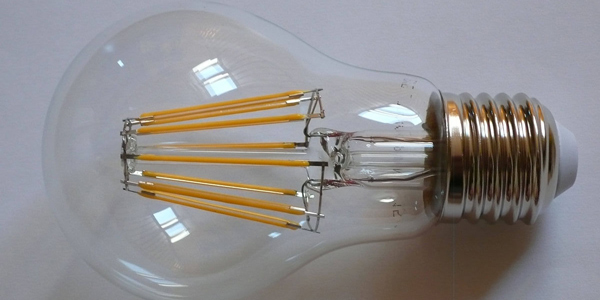In 1879, Thomas Edison patented the incandescent light bulb. For more than a century, the incandescent bulb and its upscale offspring, the halogen bulb, have reigned supreme.
The reign is ending. Light-emitting diode (LED) lighting is replacing Edison lighting.
Here’s a question: How much more impact is rooftop solar having on retail electric sales than LED lighting?
It’s a trick question. Rooftop solar has had less impact on retail electric sales. LED lighting already has reduced annual retail electric sales by 30 billion kWh. Rooftop solar has reduced annual retail electric sales by 14 billion kWh.
But it’s the future that’s really interesting. The U.S. Energy Information Administration’s latest study forecasts LED lighting over the next 20 years to reduce annual retail electric sales by 300 billion kWh under a “current path” and by 435 billion kWh under a more aggressive path.[1] Rooftop solar over the next 20 years is expected to reach 100 billion kWh annually.
Let’s think about that. For all the attention given rooftop solar as environmental boon, new age investment and regulatory flashpoint, the LED bulb is three times more significant.
And three times more significant for electric utilities. Lighting represents 15% of retail electric sales. Over the next 20 years, half of those lighting sales will disappear, perhaps three quarters under a more aggressive path. Those electric vehicles better show up soon.
And what if Haitz’s Law — the LED parallel to Moore’s Law — continues, such that the cost per lumen keeps falling by a factor of 10 every 10 years? The LED is just another form of semiconductor. The substitution could be even more rapid.
Even at today’s cost per lumen, Edison lighting is much more expensive on a life-cycle basis than LED lighting. Much, much more expensive.
A General Electric soft white 60-W Edison bulb can be had in quantity purchase for $1.30, and rated to last for 1.4 years based on an average use of three hours per day. A GE soft white 60-W equivalent LED bulb can be had in quantity purchase for $3, use 10 W and last for 13 years based on the same average. So over 13 years, Edison lighting would cost an extra $9 for the bulbs and an extra $78 for the electricity (at 11 cents/kWh).[2]
Bottom line: Rooftop solar may be all the rage, but just changing light bulbs makes a bigger dent in emissions from combusting fossil fuels. And saves money to boot. Doing good and doing well.
Watt’s in your socket?
Steve Huntoon is a former president of the Energy Bar Association, with more than 30 years of experience advising and representing energy companies and institutions. He received a B.A. in economics and a J.D. from the University of Virginia. He is the principal of Energy Counsel LLP.
[1] You won’t find these forecasts in EIA’s “Annual Energy Outlook 2016,” which forecasts a lighting consumption decline of only 28% from 2015 to 2040 (Figure IF3-3). Instead the forecasts are derived from EIA’s specialty study “Energy Savings Forecast of Solid-State Lighting in General Illumination Applications” (September 2016) and require interpolating from Tables 4.2 and Figure 4.2, and converting from British thermal units to kilowatt-hours and from source to sink.
[2] Edison lighting also costs more for the incremental air conditioning in the summer to combat the heat from the bulb. (Generally, this extra cost is more than the incremental heating savings in the winter.)



